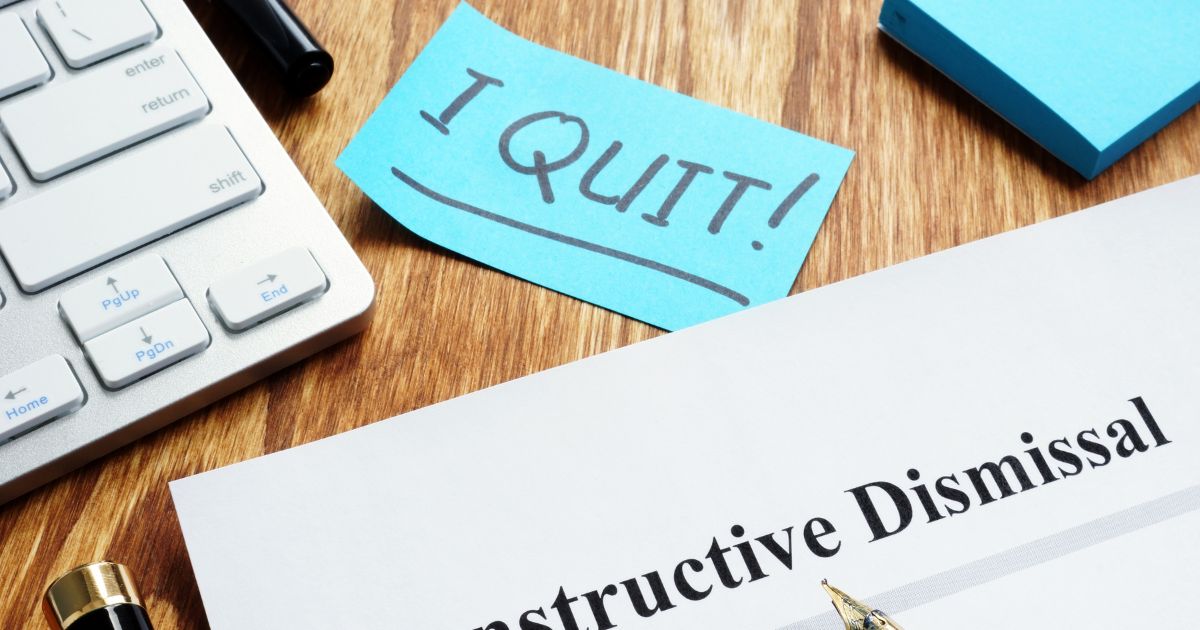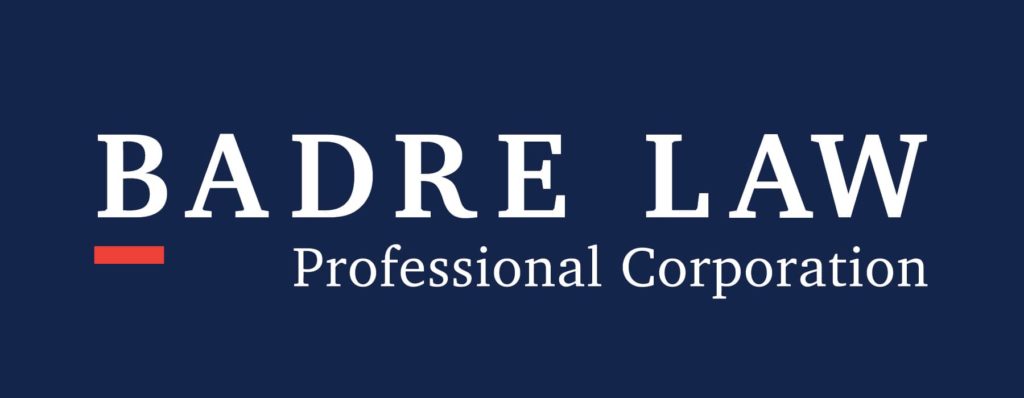As an employee, you have the right to work in a safe and fair environment. Unfortunately, some employers may create intolerable working conditions that you feel forced to resign. This is known as constructive dismissal, a legal term and common law used to describe situations where an employer’s conduct or behavior makes it impossible for an employee to continue working.
While constructive dismissal can be challenging to prove, recognizing the signs is essential for protecting your rights as an employee. This expert guide will explain constructive dismissal in Ontario, the difference between constructive and wrongful dismissal, and how to identify the signs of constructive dismissal.
By understanding what to look out for and how to address it, you can take the necessary steps to ensure that you are treated fairly in the workplace.
Understanding Constructive Dismissal
You can protect your rights as an employee if you have a more profound understanding of a constructive dismissal claim. This condition occurs when an employer creates intolerable working conditions, forcing an employee to resign. However, identifying the signs and taking the necessary steps to address it can be challenging.
Definition of constructive dismissal
Besides being a common law, constructive dismissal is a legal term used to describe a situation where an employee is forced to resign due to their employer’s behavior. It occurs when an employer breaches a written employment contract or creates intolerable working conditions that leave an employee with no choice but to resign.
The employer’s conduct must be so severe that it creates substantial changes in the employment relationship, making it impossible for the employee to continue working. Reducing an employee’s salary or hours, demoting them, changing their job duties, or subjecting them to harassment or discrimination are considered behaviors leading to constructive dismissal in Ontario.
In most cases, constructive dismissal occurs over an extended period, making it difficult to pinpoint a specific incident. Therefore, it is critical to record all incidents and consult with legal professionals to determine if your case meets the criteria to claim constructive dismissal.
Difference between wrongful and constructive dismissal
The main difference between wrongful and constructive dismissal is that constructive dismissal is a breach of the employment contract by the employer. In contrast, wrongful dismissal is the termination of an employee without reasonable cause. It occurs when an employer terminates an employee without giving them proper notice or compensation, violating the employment agreement terms.
In contrast, constructive dismissal occurs when an employer creates intolerable working conditions that force an employee to resign. While both types of dismissal can lead to a breach of the employment contract, constructive dismissal usually involves a gradual buildup of adverse circumstances; meanwhile, wrongful dismissal is usually a one-time event.
Additionally, wrongful dismissal cases typically involve compensation for lost wages, whereas constructive dismissal cases often focus on compensation for damages related to the employee’s resignation.
It is essential to understand the difference between these two types of dismissals, as the legal requirements and options for employees can differ depending on the situation.
Examples of constructive dismissal
Examples of constructive dismissal can include various employer behaviors that make an employee’s work environment unbearable. As previously mentioned, some examples may include reducing an employee’s salary or hours, demoting them, changing their job duties, or subjecting them to harassment or discrimination.
These actions are considered a breach of the employment contract and fundamentally change the employment relationship, making it impossible for the employee to continue working.
Meanwhile, other examples of constructive dismissal can include:
- Ignoring an employee’s complaints or concerns about their work environment.
- Refusing to provide necessary equipment or resources.
- Failing to address a toxic workplace culture.
Constructive dismissal can also occur when an employee is forced to work in dangerous or unsafe conditions or when an employer requires an employee to perform illegal or unethical tasks.
It is vital to document any incidents that may be considered constructive dismissal and to seek legal advice from an experienced employment lawyer to determine if you have a case.

Signs of Constructive Dismissal in Ontario
Protecting your rights as an employee should be your top priority, but it can also be intricate to tell when to take action when your employer creates unbearable working conditions.
Understanding constructive dismissal signs is the only way to identify when your employer is acting unlawfully and gain knowledge to take the appropriate steps.
Here are some signs of constructive dismissal:
Changes in job duties or responsibilities
Suppose your employer makes a unilateral and substantial alteration to your job duties or responsibilities without your agreement. In that case, it can make your working conditions unbearable and fundamentally change the employment relationship.
Suppose you were hired as a marketing manager but are suddenly expected to perform accounting tasks without proper training or sufficient employee’s compensation. In that case, such substantial changes could be considered constructive dismissal.
Similarly, if your employer suddenly demotes you or transfers you to a different department without explanation or justification, you can claim constructive dismissal case.
If you are experiencing significant changes to your job duties or responsibilities, it is valuable to document the changes and communicate with your employer to understand the reasons behind them.
If you feel the changes are unjustified and have made your work environment unendurable and constructively dismissed, you may seek legal advice to determine and prove constructive dismissal.
Unreasonable changes in work schedule or location
Suppose your employer suddenly changes your work schedule or requires you to work at a different location without reasonable notice or explanation. In that case, this can substantially impact your work-life balance and make your working conditions intolerable.
Employment law implies, for example, if you were hired to work a regular 9-5 schedule. Still, claiming constructive dismissal may be appropriate if your employer suddenly requires you to work evenings and weekends.
Suppose your employer requires you to work at a location significantly farther from your home or requires additional expenses, such as tolls or parking fees. In that case, this could also be a sign of constructive dismissal.
Documenting the changes and discussing these matters with your employer is decisive if you need a substantial change to your work schedule or location.
Suppose work schedule and location changes are unjustified and have made your work environment unacceptable. In that case, consider seeking legal advice to pinpoint if you have grounds to claim constructive dismissal.
Workplace harassment or bullying
An employer making substantial offensive behavior, such as verbal or physical abuse, discrimination, or harassment, can create a toxic work environment and make your working conditions and employment relationships intolerable. This behavior can also come from coworkers, managers, or other individuals within the workplace.
Examples of workplace harassment or bullying can include inappropriate comments, exclusion from work activities, unwarranted criticism, or sabotaging your work.
Recording and reporting unhealthy behaviors to your employer is relevant, particularly if you’re experiencing sexual harassment or bullying in the workplace. If your employer fails to take appropriate action, it may be necessary to seek legal advice.
As a reasonable person, you must not endure harassment or bullying in the workplace. It is imperative to take action to prevent workplace harassment and protect your rights and well-being.
Discrimination or retaliation
Experiencing discrimination, retaliation, or constructive dismissal based on gender, race, religion, age, or any other protected characteristic can create a toxic work environment and make your work conditions intolerable.
Discrimination can include being passed over for promotions, receiving unequal pay, or being mistreated. Report wrongdoing or participate in an investigation and face retaliation from your employer, such as being demoted, fired, or subject to hostile behavior. These can also be signs of constructive dismissal situations.
You must not ignore your employer’s conduct, workplace discrimination, or retaliation behaviors and report them immediately to your superiors. Consult an employment lawyer if your superiors fail to take the required steps in such a claim.
Lack of support or resources

An untenable and toxic work environment can be caused by needing more tools, training, or support to perform employee’s job responsibilities effectively. This can include insufficient staff, inadequate equipment or technology, or lack of training or guidance. Let your employer know if you need specific tools to perform your tasks effectively.
Claim constructive dismissal involves documenting your concerns and formally requesting additional resources or support. If your employer does not respond appropriately, seeking legal advice can verify if you have a constructive dismissal case.
According to employment standards, employees should only be expected to perform their duties with adequate support and resources.
Negative performance reviews without justification
Receiving negative performance reviews without clear and justifiable reasons can create a taxing and demoralizing work environment. Negative performance reviews can impact job security, promotions, and overall job satisfaction.
Receiving negative feedback without clear explanations or constructive criticism can make improving and succeeding in your job challenging. Reviewing your job description and performance expectations and documenting any unfair or unfounded criticism in your performance reviews is fundamental.
You should also schedule a meeting with your supervisor to discuss your concerns and request specific examples of your shortcomings. If your employer fails to provide reasonable justification for the negative performance reviews, seeking legal advice can help you identify if you have a case for an employer’s breach.
Refusal to address workplace concerns or complaints
If you bring up workplace concerns or complaints to your employer or HR department and they refuse to address them, it may be a sign that constructive dismissal occurs. Employers are responsible for maintaining a safe and healthy employee work environment.
If they fail to address concerns related to harassment, discrimination, safety, or other workplace issues, it can create a hostile work environment that can lead to a resignation. When raising concerns, it is valuable to document the issue, including the date, time, and individuals involved.
You should also make a formal complaint through the proper channels and follow up to ensure that it is being addressed. If your employer fails to address the issue or retaliates against you for bringing it up, a legal consultation or the court of appeal can resolve if you have a case for an employer’s breach.
Remember, you have the right to a safe and respectful work environment; it is indispensable to advocate for yourself if your employer fails to provide a fair employee’s employment contract.
What to do if you suspect Constructive Dismissal?
Constructive dismissal can seriously affect your career, well-being, and financial security. Whether these are changes in job duties, sexual harassment by coworkers, or discrimination by your employer, addressing the issue as soon as possible is critical.
Ultimately, the best course of action will depend on the specifics of your situation, but it’s best to act quickly and proactively to protect yourself and your future.
Document all incidents and conversations
Documenting all incidents and conversations related to constructive dismissal in Ontario is crucial if you suspect you may be a victim. This includes any changes in job duties, performance reviews, bullying or harassment by coworkers, or any other actions that suggest you are being constructively dismissed.
By keeping a detailed record of these incidents when claiming constructive dismissal, you will have evidence to support your case if you need to take legal action or file a complaint with your former employer.
Be sure to include each incident’s date, time, and specifics and the names of any witnesses or individuals involved. This documentation can be critical in helping you to protect your rights and ensure that you receive fair treatment in the workplace.
Speak to HR or a supervisor
If you suspect that you are a victim of constructive dismissal, it’s crucial to speak to your HR representative or supervisor as soon as possible. They may need to be aware of such a breach and can work with you to find a solution.
Provide specific examples and explain how you feel that the actions taken by your employer or coworkers have created an unfavorable or intolerable work environment.
If you feel uncomfortable speaking with HR or your supervisor, consider seeking assistance from an employment lawyer or a government agency that deals with labor issues. Taking urgent action can help you receive fair treatment in the workplace.
Seek legal advice
An experienced employment lawyer can help you understand your rights and options and provide guidance on the best course of action. They can also help you negotiate with your employer and pursue legal action if necessary.
Addressing constructive dismissal can be complex and time-consuming, so having a knowledgeable and skilled legal representative on your side is a big help.
Seeking legal advice early on can also help you ensure that you’re taking the proper steps to protect yourself and your interests and can help you avoid making costly mistakes that could harm your case.
File a complaint with the appropriate agency.
You may file a complaint with the appropriate agency if you have evidence of constructive dismissal and have exhausted all internal avenues. Depending on your country or state, this may be a labor board or human rights commission.
These agencies are designed to investigate workplace mistreatment complaints and employment relationship’s terms, providing legal recourse if appropriate. However, expect that filing a complaint can be stressful and requires a significant period of time.
Consider seeking the help of employment lawyers before proceeding, as it can be complex and may require evidence to support your claim. Sometimes, the agency may try to mediate a resolution between you and your employer.
Explore other job opportunities

It may be worth exploring other job opportunities if you suspect or experience constructive dismissal in your current job. While it can be challenging to find a new job, it may be the best solution to avoid further stress and negative impact on your mental and physical health.
Update your resume, contact your professional network, and look for new job openings that fit your skills and qualifications. Be transparent about your previous job experience, but avoid badmouthing your previous employer during interviews.
By exploring other job opportunities, you may find a better work environment where you can thrive and be valued as an employee.
Final Thoughts
Constructive dismissal can be a complex and challenging issue for employees to deal with in the workplace. Recognizing the signs and documenting incidents that may lead to them is crucial.
Employees should pay attention to concerns and speak to their superiors or HR representatives about workplace issues. Seeking legal advice or filing a complaint with the appropriate agency may also be necessary to protect one’s rights and interests.
Finally, exploring other job opportunities may be brilliant if employees believe their job is no longer sustainable. By being proactive and taking appropriate action, employees can navigate through the difficult situation of constructive dismissal Ontario and protect their well-being and employee rights at work.

